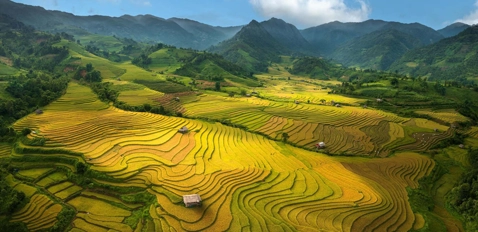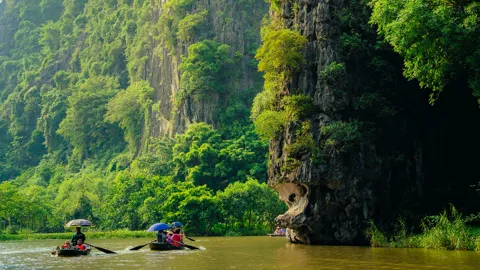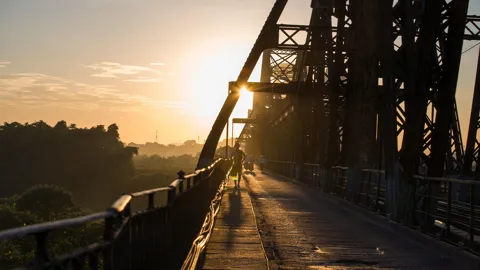Tay Phuong Pagoda: Where Silence Speaks And The Soul Finds Peace
Tay Phuong Pagoda in Thach That boasts an artistic architectural style and a timeless, unique beauty that words can hardly capture. Located just a few dozen kilometers from Hanoi’s center, it promises to be a memorable destination for spiritual tourism, sightseeing, and worship.
A Glimpse At Tay Phuong Pagoda
Tay Phuong Pagoda (also known as Sung Phuc Tu or Tay Phuong Ancient Pagoda) is the second oldest pagoda in Vietnam, after Dau Pagoda in Bac Ninh. Located about 40 kilometers west of central Hanoi, it sits in Thach Xa Commune, Thach That District. As a Special National Relic, this ancient temple has remarkably preserved its rare beauty and intricate sculptures over the years. A fascinating destination on the outskirts of the capital, it attracts a large number of visitors and pilgrims from all over.
Historical Background
This pagoda is associated with a legend about the early spread of Buddhism into Vietnam. Over the centuries, another tale emerged about Gao Pian, a Tang Dynasty military governor (864–868) who ruled over the former Annam region. According to the story, he came to this area to build a religious structure with the hidden intention of suppressing the spiritual energy (dragon vein) of the land.
However, legends remain just that—legends—passed down orally through generations. The most verifiable historical evidence of Tay Phuong Ancient Pagoda dates back to the reign of Mac Phuc Nguyen (1547–1561), during which the pagoda was built on the same scale as seen today.
In 2015, Tay Phuong Pagoda was officially recognized by the Prime Minister as a Special National Relic. Among its treasures are 34 statues that have been designated as national treasures.
Architectural Highlights
The architectural complex of Tay Phuong Pagoda begins at the foot of Cau Lau Mountain, featuring structures such as the Lower Three-Entrance Gate, Upper Three-Entrance Gate, Mountain Deity Shrine, Front Hall, Central Hall, and Upper Sanctuary. Join us as we explore the unique and fascinating architecture of this ancient pagoda.
Lower Three-Entrance Gate (Tam Quan Ha)
The architectural journey of Tay Phuong Pagoda begins with the first structure—the Lower Three-Entrance Gate. This gate features three doorways, with the central one being the largest and widest. In Buddhism, the three entrances symbolize three perspectives: “Huu Quan” (perceived reality), “Khong Quan” (emptiness), and “Trung Quan” (the middle path). Huu Quan represents form and the tangible, impermanent world; Khong Quan symbolizes emptiness and the transient nature of existence; while Trung Quan reflects the balance and harmony between form and emptiness.
237 Ancient Laterite Steps
Beyond the Three-Entrance Gate lies a staircase of 237 ancient laterite steps leading up to the pagoda. Covered in moss, the steps are low and gently sloped, making the climb both scenic and comfortable.
Upper Three-Entrance Gate (Tam Quan Thuong)
The Upper Three-Entrance Gate stands just beyond the laterite steps, right before the main courtyard of the pagoda. Built in the style of traditional Buddhist architecture, this gate adds an ancient charm to the sacred space.
Inscribed on the pillars are two poetic lines:
“Seven golden lotuses cradle his sacred steps;
Three thousand worlds welcome the Tathāgata.”
These verses commemorate a pivotal event in Buddhist history—the birth of the Buddha. Legend has it that upon his birth, he took seven steps, and with each step, a lotus bloomed beneath his feet. At the seventh step, he pointed one hand to the sky and the other to the earth, proclaiming: “Above and below the heavens, I alone am the honored one.”
Shrine Of The Mountain Deity
The Shrine of the Mountain Deity is set apart to the left of the main pagoda. This small, humble structure serves a dual purpose: it is both a place to worship the mountain god and a sanctuary dedicated to Duc ong (the Venerable Patron). Built with traditional wooden architecture and a tiled roof, the shrine reflects simplicity and reverence. Most traditional Buddhist temples in Vietnam include a separate altar dedicated to Duc Ong.
Main Pagoda
The Main Pagoda is the central structure of the entire Tay Phuong Pagoda complex. It follows the traditional “I”-shaped layout (Cong shape) and consists of three main halls: Tien Duong (Front Hall), Trung Duong (Middle Hall), and Thuong Dien (Upper Hall).
Tien Duong (Front Hall)
The Front Hall features a raised eave structure about 1 meter high and is enclosed by wooden panels. It is built in a traditional wooden frame style known as chong diem (stacked roof layers), with two tiers and eight gracefully curved “ship blade” roofs. The front of the hall is enclosed by wooden buc ban doors in the three central bays, while the two sides are built with exposed bricks without plaster—a distinctive wall design used consistently across all three buildings in the complex.
Trung Duong (Middle Hall)
The Middle Hall is narrower but taller than both the Front and Upper Halls. Each section features a double-tiered roof in the chong diem (stacked roofs) style. The wooden pillars rest on green stone bases carved with lotus petal motifs. This hall is dedicated to the worship of the Snow Mountain Buddha (Phat Tuyet Son)—a statue that depicts Siddhārtha Gautama during his period of extreme asceticism, before attaining enlightenment.
Thuong Dien (Upper Hall)
The Upper Hall houses numerous Buddha statues representing the past, present, and future lives of the Buddha. The Arhats (La Han) of Tay Phuong Pagoda are arranged in vertical rows, each portraying events from the Buddha’s life. On the second row of the Upper Hall, the Ten Kings of Hell (Thap dien Diem Vuong) are displayed—a symbolic set meant to educate people about morality, encouraging them to cultivate virtue and do good deeds.
Ancestral Hall – Mother Goddess Hall – Guest Hall
The Ancestral Hall (Nha To) and Mother Goddess Hall (Nha Mau) share an “=”-shaped layout. The front section is dedicated to venerating Buddhist patriarchs, while the inner section honors the Mother Goddess.
The Guest Hall (Nha Khach) is located on the right side of the Main Hall. Although this structure was recently reconstructed, it faithfully follows traditional architecture and harmonizes with the overall design of the Tây Phương Pagoda complex.
Tay Phuong Pagoda – “Museum Of Buddhist Statues”
In addition to its unique architecture, Tây Phương Pagoda is often referred to as Vietnam’s “Museum of Buddhist Statues.” A visit to this spiritual site during your Hanoi trip offers a chance to admire 64 statues, including elaborately lacquered and gilded ones, considered masterpieces of Vietnamese sculpture. Highlights include:
The Eight Vajra Warriors (Bat Bo Kim Cuong): Each statue stands about 3 meters tall, with a dignified posture and benevolent expression. Crafted from wood and assembled by highly skilled artisans.
The Three Buddha Statues of the Past, Present, and Future (Tam The Phat): Dating back to the 17th century, these three meditating figures represent the past, present, and future lives of Buddha.
The Snow Mountain Statue (Tuyet Son): Depicting Buddha Shakyamuni during his ascetic period, this statue captures a lean and meditative figure.
The Maitreya Buddha (Phat Di Lac): Portrayed with a plump figure and joyful facial expression, symbolizing happiness and abundance.
The 18 Arhats (La Han): Created in the 18th century, this set is a rare and priceless example of ancient Vietnamese sculpture. Each Arhat is depicted with a unique posture and expression, representing individual struggles and emotions.
Spiritual And Cultural Experiences
When visiting Tây Phương Pagoda, you’ll have the chance to join meditation sessions, attend Dharma talks, pay homage, or simply take part in the vibrant pagoda festivals. Each activity offers a unique spiritual experience that leaves a lasting impression.
Pray for Peace & Blessings: With a history spanning centuries, Tay Phuong is considered one of the most sacred pagodas in Northern Vietnam. Here, you can offer prayers for peace and good fortune before the Buddha, immersing yourself in the beauty of Buddhism and the serene atmosphere of the monastery.
Enjoy Scenic Views & Take Photos: Perched atop a hill, Tay Phuong Pagoda offers breathtaking, poetic views of the surrounding countryside. The climb up the stone steps and the panoramic scenery from above provide a sense of calm and tranquility. Don’t forget to capture some stunning check-in photos to remember your peaceful journey into this sacred space.
Tay Phuong Pagoda Festival: One of the most significant cultural events here is the Tay Phuong Pagoda Festival, held annually on the 6th-10th day of the third lunar month. During the festival, the pagoda comes alive with incense offerings, solemn Buddhist rituals, traditional folk games, and captivating performances that reflect the region’s spiritual devotion and communal spirit.
Travel Tips For Visiting Tay Phuong Pagoda
Best Time To Visit
The best time to visit Tay Phuong Pagoda is during its annual festival, which takes place from the 6th to the 10th day of the third lunar month. However, you can also visit at any time of the year to enjoy the peaceful atmosphere and admire the unique architecture of this ancient pagoda.
How To Get There From Hanoi
Tay Phuong Pagoda is located about 40 kilometers west of central Hanoi. The route to the pagoda is relatively convenient and easy to navigate. Visitors can choose from the following means of transportation:
By Private Vehicle
From Hanoi, take the route via Tran Duy Hung Street – Thang Long Boulevard. When you reach the overpass at the Thang Long Boulevard – Thach That – Quoc Oai intersection, turn left toward Quoc Oai. Then turn right and continue for about 5km. At Thach Xa intersection, you’ll see a sign pointing to Tay Phuong Pagoda. Turn left there and go another 4–5km to reach the pagoda gate.
By Public Transport
Take bus route number 89, which departs from Yen Nghia Bus Station, passes through Thach That, and heads to Son Tay Bus Station. Get off at the Tay Phuong Pagoda stop.
Entrance Fees
The entrance fee to Tay Phuong Pagoda is 10,000 VND per person, applicable to both domestic and international visitors (excluding parking fees). Additionally, admission is free on special occasions, such as Vietnam Cultural Heritage Day (November 23) and during the Lunar New Year holidays on the 30th, 1st, 2nd, and 3rd days of Tet.
What To Prepare
Tay Phuong Pagoda is a sacred place, so visitors are advised to avoid wearing flashy or inappropriate clothing that could detract from the solemn atmosphere.
Wear Comfortable Footwear: Prepare for a moderate climb, as you’ll need to ascend 237 stone steps to reach the main pagoda. Sneakers or comfortable walking shoes are highly recommended.
Offer Incense Safely: If you wish to make offerings or light incense, please do so at the outdoor censer. This precaution helps prevent fire hazards, as the pagoda is primarily constructed from wood.
Be Alert During Festivals: During major festivals, especially Tay Phuong Pagoda Festival, large crowds from across the country gather here. To avoid theft, keep your personal belongings secure and stay vigilant.
Who It’s Suitable For
Tay Phuong Pagoda is an ideal destination for those who appreciate cultural heritage, traditional architecture, and spiritual experiences. It particularly appeals to culture lovers, art history enthusiasts, photographers seeking unique angles, and travelers looking for a quiet, reflective space away from the city. Whether you’re drawn by its ancient wooden sculptures or the serene atmosphere, this pagoda offers a meaningful stop on any cultural journey.
Nearby Attractions To Combine
Thay Pagoda (5 km away): A short ride from Tay Phuong, Thay Pagoda sits at the foot of Sai Son Mountain and is renowned for its serene Long Tri Lake, ancient wooden halls, and traditional water puppet stage . It offers a complementary spiritual experience with its mix of architecture, folklore, and natural beauty.
Ba Vi National Park (≈60 km, ~1 h drive): A lush natural escape renowned for its three mountain peaks—King Peak, Tan Vien Peak and Ngoc Hoa Peak—alongside French colonial ruins, diverse ecosystems, and cultural sites like the Upper Temple and Ho Chi Minh’s memorial. Highlights include trekking trails, bird watching, and waterfalls. Ideal for nature lovers and hikers.
Duong Lam Ancient Village (≈50 km, ~1–1.5 h drive): Vietnam’s first recognized ancient village, Duong Lam is home to over 900 laterite houses, centuries-old banyan trees, ancient communal gates, and temples. It’s a living museum offering a rich glimpse into traditional rural life, with experiences like calligraphy workshops, rice paper making, and homestays in historic homes.
Tay Phuong Pagoda: A Sanctuary Of Spiritual And Artistic Beauty
Perched atop a high hill, the ancient architecture of Tay Phuong Pagoda is weathered with moss, bearing the marks of time. Yet for many visitors, every trip to Tay Phuong Pagoda in Thach That—whether to enjoy the scenery, pay respects to the Buddha, or admire the precious statues—is a truly unforgettable experience. If you have the time, be sure to visit this place to feel the peace, serenity, and calm it brings to the soul.
>>> Thay Pagoda: An Artistic Treasure of Architecture in the Heart of Hanoi
>>> Quan Thanh Temple: A Sacred Landmark of Hanoi’s Spiritual and Cultural Heritage
Send us your comments about : Tay Phuong Pagoda: Where Silence Speaks And The Soul Finds Peace
Required fields *
You might also be interested
Travel ideas
Need some inspiration? Discover some of the best tours in Vietnam, which are highly appreciated by our clients. An excellent starting point to help you choose the right trip to Vietnam, Laos, Cambodia, Burma or Thailand, whether you are traveling alone, as a couple, as a family or with friends.
And because this trip is yours, feel free to customize it as you wish!
Vietnam Cambodia Itinerary 14 Days
Hanoi – Hoa Binh – Mai Chau – Ninh Binh – Halong bay – Hue - Danang – Hoian – Saigon – Ben Tre - Can Tho – Saigon - Siem Reap Angkor - Tonlé Sap - Siem Reap – Ta Prohm - Departure
Vietnam 14 Day Itinerary
Vietnam 14-day itinerary covers the country’s top highlights and quintessential experiences for an unforgettable journey.
Honeymoon Tour Pakcages In Vietnam 12 Days
Saigon Arrival - City Tour – Mekong Delta – Danang – Hoian - by flight - Da Nang – Hanoi - by flight – Halong - overnight on junk – Departure
Authentic Hoang Su Phi Trekking Tours
Hoang Su Phi trekking tours take you to stunning terraces, meet few tourists, connect with locals and enjoy authentic culture.
Best Nha Trang Beach Tour 4 Days
Saigon/Hanoi – Nha Trang relaxation – Saigon/Hanoi – Departure
Mekong Delta Bike Tour Itinerary 7 Days
Cycle through the Mekong Delta in 7 days, discovering floating markets, orchards, craft villages, and tranquil green islands.
Are you interested in this tour?





































Comment